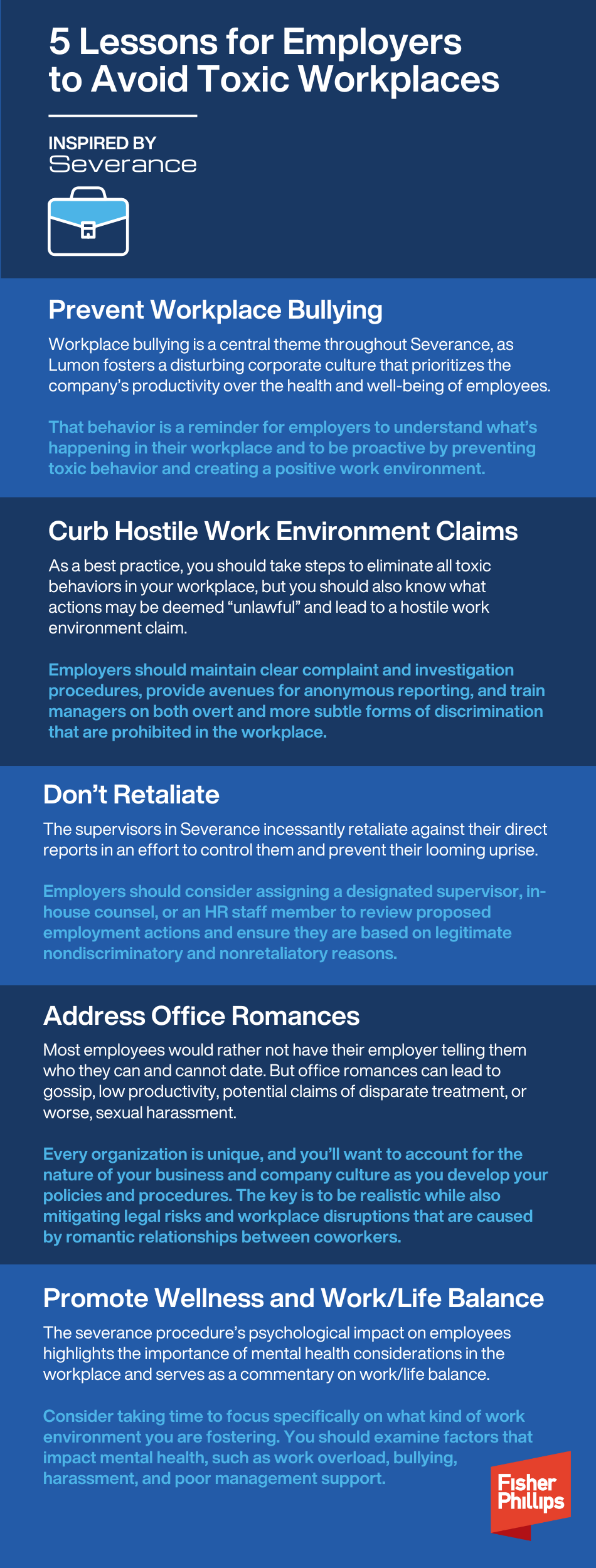Severance Highlights Toxic Workplace Themes That Aren’t Just Sci-Fi: 5 Spoiler-Free Lessons for Employers
Insights
4.01.25
Apple TV’s hit dystopian workplace series Severance follows four employees at a mysterious company who perform critical yet cryptic work during their seemingly mundane 9-5. These employees have agreed to undergo a controversial surgery known as “severance” to insert a chip in their brains and create two distinct identities called an “innie” and “outie.” One solely focuses on work and the other experiences a blissful work-free existence. The first season follows the “innie” employees who exist solely in the confines of their workplace. In the second season, the employees learn the dire consequences of trifling with the severance barrier. Both present thought-provoking employment law themes – even if the overall premise is unrealistic. Here are five lessons from Severance that can help you improve your workplace culture.
Note: This Insight contains summaries of the general plot you'd pick up from the trailer but no spoilers.
1. Prevent Workplace Bullying
Central to Severance is the cultish corporate culture at Lumon Industries, which praises the company’s founder, Kier Eagan, and sets the stage for a toxic environment from leadership down. Indeed, on supervisor said she wanted to “pummel” an employee. There’s also the repeated psychological abuse that occurs in the dreaded “Break Room” where the Severance employees have to ask for forgiveness 1,000 times.
Workplace bullying is a central theme throughout Severance, as Lumon fosters a disturbing corporate culture that prioritizes the company’s productivity (with an endgame that’s still unknown) over the health and well-being of employees. Employees are subject to manipulation, intimidation, and physical threats, as well as passive-aggressive behavior and micro-aggressions from the company’s leadership.
This behavior is extreme, but it’s also a reminder for employers to understand what’s happening in their workplace and to be proactive by preventing toxic behavior and creating a positive work environment.
| Practical Tip: Employers may choose to go beyond what is legally required and create an anti-bullying policy that sets workplace expectations and guidelines and addresses problematic behavior before it escalates. Be sure to clearly define what behavior is and isn’t acceptable, train managers on how to handle issues as they arise, and consistently enforce your policies. Work with legal counsel to ensure your policies and practices align with applicable employment laws, including Title VII of the Civil Rights Act and the National Labor Relations Act. You should also note that some state harassment-prevention training requirements include an anti-bullying component. Click here for seven steps to prevent workplace bullying. |
2. Curb Hostile Work Environment Claims
As a best practice, you should take steps to eliminate all toxic behaviors in your workplace, but you should also know what actions may be deemed “unlawful” and lead to a hostile work environment claim under federal or state anti-discrimination laws. While workplace bullying is unhealthy and unproductive, it doesn’t generally constitute unlawful harassment unless it is based on a protected characteristic, such as age (40 and above), disability, genetic information, national origin, race, color, religion, or sex. Notably, many states have laws that protect employees based on additional characteristics.
Harassment becomes unlawful, according to the Equal Employment Opportunity Commission (EEOC), when:
- enduring the offensive conduct becomes a condition of continued employment; or
- the conduct is severe or pervasive enough to create a work environment that a reasonable person would consider intimidating, hostile, or abusive.
Such action may potentially be attributable to the company if the harasser is a manager or supervisor, or even a co-worker if the company knew or should have known about the harassment and failed to prevent or correct it.
| Practical Tip: In addition to developing and consistently following anti-discrimination and anti-harassment policies, employers should maintain clear complaint and investigation procedures, provide avenues for anonymous reporting, and train managers on both overt and more subtle forms of discrimination that are prohibited in the workplace. |
3. Don’t Retaliate
The supervisors in Severance incessantly retaliate against their direct reports in an effort to control them and prevent their looming uprise. While their acts are sometimes petty and humorous, Lumon supervisors also engage in more serious retaliation that could give rise to real life employment claims, like being fired for speaking out against company policies or being threatened for making complaints about management practices.
Many anti-discrimination laws prohibit employers from punishing job applicants or employees for complaining about employment discrimination. For example, the EEOC says, it is unlawful for employers to retaliate against job applicants or employees for:
- filing or being a witness in an EEO charge, complaint, investigation, or lawsuit
- communicating with a supervisor or manager about employment discrimination, including harassment
- answering questions during an employer investigation of alleged harassment
- refusing to follow orders that would result in discrimination
- resisting sexual advances or intervening to protect others
- requesting accommodation for a disability or religious practice
- asking managers or co-workers about salary information to uncover potentially discriminatory wages
“Employers are free to discipline or terminate workers if motivated by non-retaliatory and non-discriminatory reasons that would otherwise result in such consequences,” according to the EEOC. “However, an employer is not allowed to do anything in response to EEO activity that would discourage someone from resisting or complaining about future discrimination.”
| Practical Tip: Employers should consider assigning a designated supervisor, in-house counsel, or an HR staff member to review proposed employment actions and ensure they are based on legitimate nondiscriminatory and nonretaliatory reasons. Click here for our five tips to avoid workplace retaliation claims. |
4. Address Office Romances
Of course, no TV hit series is complete without some relationship drama. In Severance, the primary romantic relationships between Irving and Burt, as well as Helly R. and Mark S., present various workplace issues for employers to consider even outside of Lumon’s labyrinth like hallways.
Most employees would rather not have their employer telling them who they can and cannot date. But from an employer’s standpoint, the risks of workplace romances are clear. What begins as a harmonious relationship can easily turn toxic – which is especially problematic if the parties involved need to work together after a breakup.
The romance could also lead to gossip fodder in the workplace, lack of productivity, potential claims of disparate treatment, or worse, sexual harassment. Even healthy relationships can negatively impact coworker morale if they are perceived as a distraction or result in favoritism.
Fortunately, there are many options available to employers to reduce risks when it comes to workplace relationships. Consider the following:
- Review Your Workplace Policies on Relationships – Employers may want to consider policies addressing romantic relationships between employees to prevent potential harassment and conflicts of interest. In addition to implementing robust anti-discrimination and harassment policies and training, there are various types of anti-fraternization policies directed specifically at this issue.
- Weigh the Risks and Benefits of Anti-Fraternization Policies – Some employers choose a policy that bans romantic relationships between all employees, giving you the ability to discipline employees involved in such relationships. The downside is that these strict policies impact employee morale and may come across as an invasion of privacy or an attempt to govern off-duty behavior. To address this concern, many anti-fraternization policies prohibit only specific romantic relationships between supervisors and subordinates, individuals within the same chain of command, or any relationship where one party has the ability to affect the terms and conditions of the other’s employment.
- Consider a “Love Contract” – This is a voluntary agreement signed by employees involved in a workplace romance, confirming the relationship is consensual and acknowledging the employer’s anti-harassment and non-retaliation policies. These agreements are designed to protect employers from potential lawsuits, particularly sexual harassment or discrimination claims.
| Practical Tip: Every organization is unique, and you’ll want to account for the nature of your business and company culture as you develop your policies and procedures. The key is to be realistic while also mitigating legal risks and workplace disruptions that are caused by romantic relationships between coworkers. You can read more about workplace romance policies here. |
5. Promote Wellness and Work/Life Balance
The severance procedure’s psychological impact on employees highlights the importance of mental health considerations in the workplace and serves as a commentary on work/life balance. Outside of the bizarre confines of Lumon, employers should consider taking a healthier approach to promoting employee well-being and work/life balance.
Here’s a reason to start the dialogue. The 2024 National Alliance on Mental Illness (NAMI) Workplace Mental Health Poll found that:
- 52% of employees polled reported feeling burned out in the past year because of their job.
- 37% of employees reported feeling so overwhelmed it made it hard to do their job.
- Around 33% noticed their productivity suffer because of their mental health – and conversely, 36% noticed their mental health suffer because of work demands.
| Practical Tip: Consider taking time to focus specifically on what kind of work environment you are fostering. You should examine factors that impact mental health, such as work overload, bullying, harassment, and poor management support. Train managers and supervisors to recognize signs of stress, burnout, and mental health issues among their team members – and lead by example by prioritizing your own work-life balance and demonstrating empathy about employees’ personal and professional challenges. Click here to learn more about mental health in the workplace. |
Conclusion
We will continue to monitor developments related to all aspects of workplace law. Make sure you are subscribed to Fisher Phillips’ Insight System to get the most up-to-date information. If you have questions, contact your Fisher Phillips attorney or the authors of this Insight.
Related People
-
- Olivia J. Italiano
- Of Counsel
-
- R. Shane Kagan
- Partner



